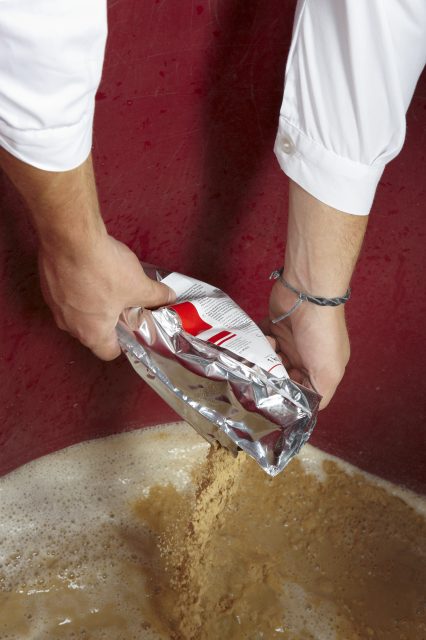This website uses cookies so that we can provide you with the best user experience possible. Cookie information is stored in your browser and performs functions such as recognising you when you return to our website and helping our team to understand which sections of the website you find most interesting and useful.
‘Yeast makes winemakers lazy’, argues Stellenbosch producer
Does using commercial yeast make winemakers lazy? One South African winemaker thinks so….

Using yeast in the winemaking process affects how quickly fermentation begins, how rapidly it progresses, and what the final product tastes like.
Whether you support adding commercial strains of yeast or cultivating native yeast from the vineyard and surrounding areas, it’s a topic that’s likely to draw an impassioned response from winemakers.
At a tasting held by South Africa’s Oldenburg Vineyards, yeast-whispering winemaker Nic van Aarde told db about his preference for all-natural fermentation and how it keeps him agile.
“Yeast makes winemakers lazy,” he said. “Your fermentation just happens, and you can actually sleep at night! With wild fermentation it’s a different story. It’s a much longer, more drawn out process.”
According to van Aarde he knows “how to keep wild yeast happy”, and it involves the somewhat unorthodox method of sunbathing.
“I take my barrels outside and put them in the sun to warm them,” he revealed. “If you come to visit the winery you’ll see all my barrels parked outside as wild yeast doesn’t like being too cold. It functions best between 18°C and 20°C.”
Van Aarde took on the winemaker role at Oldenburg, one of the smallest, newest and highest-altitude wards in Stellenbosch, in 2018, having spent eight years as head winemaker at Warwick, one of the major players in Stellenbosch wine.
“Warwick was a much bigger operation, producing around 2.2 million bottles of wine per year. On that scale, I was really more of a technical manager,” he said.
Prior to this, van Aaarde worked at wineries around the globe, including in Marlborough, Napa, Sonoma, Margaret River and Saint-Émilion, where he spent time at Premier Cru estate Château Angélus.
Contrastingly, Oldenburg, which specialises in Chenin Blanc, Chardonnay and Bordeaux blends, only built its own winery in 2019, having first begun making wines in 2007 using a neighbouring winery’s facilities.
The vineyard is nestled between mountains in “a natural amphitheatre”, which shades the vines and means they spend very little time in direct sunlight. A significant diurnal temperature range (which sees temperatures drop by 20°C between morning and night) means that “a lot of cold air flows through the valley”.
“We are the best-kept secret in Stellenbosch!”, van Aarde argues.
Speaking of his Chenin Blanc, van Aarde detailed how he favours whole bunch pressing before passing the grapes through a purpose-built “cool-room” to bring their temperature down to around 5°C .
Upon separation, 500 litres or more goes into tank while the rest of the juice goes into a press, from which sediment is mined to use for his natural fermentation.
The result, says van Aarde, is that when you try the wine “it’s like biting into an apricot”.
He attributes his efforts with natural, wild yeasts for Oldenburg having eight to ten-year-old Chenins that are still drinking well.

Clone ranger
At Oldenburg, four different clones of Chenin Blanc are jumbled up in the vineyard to create a field blend of Chenin. “Some have big berries, others much smaller. We build complexity in the wines by mixing up all these clones,” van Aarde explains.
He would never claim to be a Chenin purist, and nods towards a unique Chenin-Chardonnay blend that he also creates at Oldenburg.
“Of course if the French knew that South Africans are blending Chenin with Chardonnay they’d be up in arms, burning effigies,” he said. “But we think it’s quite cool.”
The blend is part of the CL range, named after the first two letters on vehicle registration plates in Stellenbosch.
Van Aarde also occasionally uses a small amount (around 7%) of Semillon in his Chenin Blanc.
“If you use less than 10% of a grape variety in a wine in South Africa, you don’t have to declare it on the label.”
At present, Oldenburg is “flirting with organics”, but given that the valley in which it is based receives around 1000ml of rainfall per year, and with it comes humidity and disease pressure, becoming certified organic is not high on the agenda.
“We’re concentrating more on sustainable viticulture – planting cover crops and indigenous vegetation, introducing insects etc – which has allowed us to move away from spraying herbicides,” said van Aarde.
This year has been particularly challenging in terms of rain with the 2023 vintage having seen “the wettest winter here for 60 years”.
“So far though, the harvest is looking good,” he said. “But it’s going to be a late season because we need the ground to warm up for the vines to come out of dormancy.”
Related news
Burgundy 2023 en primeurs: cautious optimism
SWR: lighter bottles for entry level wines is 'the wrong message'
Ribera del Duero challenges 'out of date' perceptions in UK market

